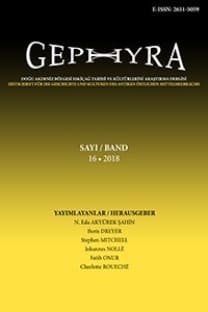Delikanlılar Delikanlı Olur: Iasos'tan Agonistik Grafitiler
Iasos'taki agonistik grafitiler, atletlerin ve hayırseverlerin başarılarının anıldığı anıtlar üzerinde olduğu gibi, kent gymnasion'unun mimari parçaları üzerine de kazınmıştır. Gymnasion'lardaki genç atletler ve eğitim alanlar kendileri ya da olasılıkla beraberindeki diğer eğitim alanlarla birlikte guruplar halinde zafer övgüleri kazımışlardır. Zamanla agonistik grafitiler Erken İmparatorluk Dönemi'nde o dönemin önemli isimlerini anmak üzere yenilenen Hellenistik Dönem anıtlarının üzerine kazınmıştır. Yazar, Iasos'taki genç atletlerin, gymnasion hayırseverlerinin ve üst düzey atletlerin anıtlarının üzerine isimlerini ve zafer övgülerini kazıyarak, kendilerini elit Hellenik statünün üstün bileşenleri olan sportif başarı ve hayırseverliğin teşvik edildiği hakim sosyal yapının içerisine yerleştirdiklerini ileri sürmektedir. Ayrıca, grafiti yazıcılar Iasos'taki anıtsal ve sivil peyzajın görüşülüp yeniden düzenlenmesine de katkıda bulunmuşlardır.
Boys Will Be Boys: Agonistic Graffiti from Iasos
In Iasos agonistic graffiti were inscribed on architectural elements (columns) of the city's gymnasia as well as on monuments commemorating the achievements of athletes and benefactors. Young athletes and trainees at the gymnasia inscribed victory acclamations for themselves or small groups, possibly their fellow training partners. At times, agonistic graffiti were inscribed on memorials of the Hellenistic era that were refurbished in the early Roman imperial period to commemorate contemporary luminaries. I argue that by inscribing their names and victory acclamations on the memorials of gymnasion benefactors and top-level athletes, young athletes from Iasos embedded themselves into a dominant social script that promoted athletic success and euergetism as preeminent components of elite Hellenic status. Furthermore, graffiti authors contributed into the process of negotiating and re-shaping the commemorative and civic landscape of Iasos.
___
- J. A. Baird – C. Taylor, Ancient Graffiti in Context. Introduction, in: J. A. Baird – C. Taylor (edd.), Ancient Graffiti in Context, Abingdon – New York 2011, 1-17.
- F. Berti – R. Fabiani – Z. Kızıltan – M. Nafissi (edd.), Wandering Marbles. Marbles of Iasos at the Istanbul Archaeological Museums, Istanbul 2010.
- W. Blümel, Neue Inschriften aus Karien II: Mylasa und Umgebung, EA 37, 2004, 1-42.
- S. Brunet, Living in the Shadow of the Past: Greek Athletes During the Roman Empire, in: B. Goff – M. Simpson (edd.), Thinking the Olympics: The Classical Tradition and the Modern Games, London 2011, 90-108.
- A. Chaniotis, Graffiti in Aphrodisias. Images-Texts-Contexts, in: J. A. Baird – C. Taylor (edd), Ancient Graffiti in Context, Abingdon – New York 2011, 191-207.
- R. Fabiani – N. Masturzo – M. Nafissi, Base for a statue of Aba daughter of Hyssaldomus and later for the athlete T. Flavius Metrobios, in: Berti et al. 2010, 175-177.
- R. Fabiani, Column with Honorary Decree for the paidonomos C. Iulius Capito, in: Berti et al. 2010, 189-191.
- P. Fröhlich, Les groupes du gymnase d'Iasos et les presbytéroi dans les cités à l'époque hellénistique, in: P. Fröhlich – P. Hamon (edd), Groupes et associations dans les cités grecques (IIIe siècle av. J.-C.-IIe siècle ap. J.-C). Actes de la table ronde de Paris, INHA, 19-20 juin 2009, Genève 2013, 59-111.
- J. R. Gillis, Memory and Identity: The History of a Relationship, in: J. R. Gillis (ed.), Commemorations. The Politics of National Identity, Princeton 1994, 3-24.
- C. Habicht, Titus Flavius Metrobios, Periodonike aus Iasos, in: P. Kneissl – V. Losemann (edd.), Imperium Romanum: Studien zur Geschichte und Rezeption. Festschrift für Karl Christ zum 75. Geburtstag, Stuttgart 1998, 311-316.
- V. Hunink, Glücklich ist dieser Ort! 1000 Graffiti aus Pompeji, Stuttgart 2011.
- P. Keegan, Graffiti in Antiquity, Abingdon – New York 2014.
- J. Ma, Statues and Cities. Honorific Portraits and Civic Identity in the Hellenistic World, Oxford 2013.
- S. G. Miller, Excavations at Nemea II. The Early Hellenistic Stadium, Berkeley – London 2001.
- J. C. Moretti, Graffites de la Palestre du lac à Délos, BCH 122, 1998, 201-212.
- M. Nafissi – N. Masturzo, Statue Base with Inscription Honouring the Athlete T. Flavius Metrobios and Agonistic Graffiti, in: Berti et al. 2010, 183-185.
- M. Nafissi, Column with Agonistic Graffiti, in: Berti et al. 2010, 192-195.
- P. Nora, Between History and Memory: Les Lieux de Mémoire, Representations 26, 1989, 7-24.
- F. Queyrel, Inscriptions et scènes figurées peintes sur le mur de fond du xyste de Delphes, BCH 125, 2001, 333-387.
- T. Reinach, Inscriptions d'Iasos, REG 6, 1893, 153-203.
- L. Robert – J. Robert, Claros I. Décrets hellénistiques, Paris 1989.
- C. Romano, Due iscrizioni greche su tabulae ansatae da Brindisi, in: Acta XII Congressus Internationalis Epigraphiae Graecae et Latinae, Barcelona 2007, 1243-1246.
- O. van Nijf, Athletics, Festivals and Greek Identity in the Roman East, Proceedings of the Cambridge Philological Society 45, 1999, 176-200.
- O. van Nijf, Local Heroes: Athletics, Festivals and Elite Self-fashioning in the Roman East, in: S. Goldhill (ed.), Being Greek under Rome: Cultural Identity, the Second Sophistic and the Development of Empire, Cambridge – New York 2001, 306-334.
- J. M. Winter, In Conclusion: Palimpsests, in: I. Sengupta (ed.), Memory, History and Colonialism: Engaging with Pierre Nora in Colonial and Postcolonial Contexts, London 2009, 167-173.
- A. Zuiderhoek, The Politics of Munificence in the Roman Empire. Citizens, Elites and Benefactors in Asia Minor, Cambridge 2009.
- A. Zuiderhoek, Controlling Urban Public Space in Roman Asia Minor, in: T. Bekker-Nielsen (ed.), Space, Place and Identity in Northern Anatolia, Stuttgart 2014, 99-108.
- ISSN: 1309-3924
- Yayın Aralığı: Yılda 2 Sayı
- Başlangıç: 2004
- Yayıncı: Nalan Eda AKYÜREK ŞAHİN
Sayıdaki Diğer Makaleler
Nakoleia'dan Bir Altar ve Yunanca-Frigce Yazıtları
Stadiasmus Patarensis için Parerga (15): Kasaba Ovası Çevresinin Yol Ağı
Bursa Müzesi'nden İki Yeni Mezar Yazıtı
Bir Hata ve Sonuçları: Side'li Marcellus, İmparator Hadrianus'un Özel Bir Hekimi ?
Kilikia Bölgesi'ndeki Tarsus Müzesi'nden Hellenistik ve Roma Dönemi Stelleri
Yukarı Menderes Vadisi'nde (Çal Ovası) Bulunan, Zeus Trossou Kültüne İlişkin Yeni bir Kamu Yazıtı
Esengül AKINCI ÖZTÜRK, Hasan BAYSAL, Marijana RİCL
Delikanlılar Delikanlı Olur: Iasos'tan Agonistik Grafitiler
